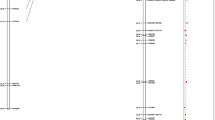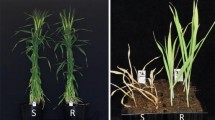Abstract
Key message
This study demonstrates the feasibility of developing co-segregating markers and identifying candidate genes for Fusarium crown rot resistance in barley based on the generation and exploitation of a near-isogenic line-derived large population.
Abstract
Fusarium crown rot (FCR) is a chronic and severe disease in cereals in semi-arid regions worldwide. Previous studies showed that FCR assessment could be affected by many factors including plant height, growth rate as well as drought stress. Thus, accurate assessment, which is essential for detailed mapping of any locus conferring FCR resistance, is difficult. Targeting one of the resistance loci reported earlier, we developed a near-isogenic line-derived population consisting of 1820 F9 lines. By analysing this population, the Qcrs.cpi-4H locus was mapped to an interval of 0.09 cM covering a physical distance of about 637 kb and 13 markers co-segregating with the targeted locus were developed. Candidate genes underlying the resistance locus were identified by analysing the expression and sequence variation of genes in the targeted interval. The accurate localization and the development of co-segregating markers should facilitate the incorporation of this large-effect QTL into breeding programmes as well as the cloning of gene(s) underlying the locus.



Similar content being viewed by others
References
Bai Z, Liu C (2015) Histological evidence for different spread of Fusarium crown rot in barley genotypes with different heights. J Phytopathol 163:91–97
Chakraborty S, Liu C, Mitter V, Scott J, Akinsanmi O, Ali S, Dill-Macky R, Nicol J, Backhouse D, Simpfendorfer S (2006) Pathogen population structure and epidemiology are keys to wheat crown rot and Fusarium head blight management. Australas Plant Pathol 35:643–655
Chakraborty S, Obanor F, Westecott R, Abeywickrama K (2010) Wheat crown rot pathogens Fusarium graminearum and F. pseudograminearum lack specialization. Phytopathology 100:1057–1065
Chen G, Liu Y, Ma J, Zheng Z, Wei Y, McIntyre CL, Zheng Y, Liu C (2013a) A novel and major quantitative trait locus for Fusarium crown rot resistance in a genotype of wild barley (Hordeum spontaneum L.). PLoS One 8:e58040
Chen G, Liu Y, Wei Y, McIntyre C, Zhou M, Zheng Y, Liu C (2013b) Major QTL for Fusarium crown rot resistance in a barley landrace. Theor Appl Genet 126:2511–2520
Chen G, Yan W, Liu Y, Wei Y, Zhou M, Zheng Y, Manners JM, Liu C (2014) The non-gibberellic acid-responsive semi-dwarfing gene uzu affects Fusarium crown rot resistance in barley. BMC Plant Biol 14:22
Chen G, Habib A, Wei Y, Zheng Y, Shabala S, Zhou M, Liu C (2015) Enhancing Fusarium crown rot resistance by pyramiding large-effect QTL in barley. Mol Breed 35:26
Cobbett C, Goldsbrough P (2002) Phytochelatins and metallothioneins: roles in heavy metal detoxification and homeostasis. Annu Rev Plant Biol 53:159–182
Habib A, Shabala S, Shabala L, Zhou M, Liu C (2016) Near-isogenic lines developed for a major QTL on chromosome arm 4HL conferring Fusarium crown rot resistance in barley. Euphytica 209:555–563
Habib A, Powell J, Stiller J, Liu M, Shabala S, Zhou M, Gardiner D, Liu C (2018) A multiple near isogenic line (multi-NIL) RNA-seq approach to identify candidate genes underpinning QTL. Theor Appl Genet 131:613–624
Hogg AC, Johnston RH, Johnston JA, Klouser L, Kephart KD, Dyer AT (2010) Monitoring Fusarium crown rot populations in spring wheat residues using quantitative real-time polymerase chain reaction. Phytopathology 100:49–57
Ke Y, Deng H, Wang S (2017) Advances in understanding broad-spectrum resistance to pathogens in rice. Plant J 90:738–748
Klein M, Burla B, Martinoia E (2006) The multidrug resistance-associated protein (MRP/ABCC) subfamily of ATP-binding cassette transporters in plants. FEBS Lett 580:1112–1122
Kosambi DD (1943) The estimation of map distances from recombination values. Ann Eugen 12:172–175
Li X, Liu C, Chakraborty S, Manners JM, Kazan K (2008) A simple method for the assessment of crown rot disease severity in wheat seedlings inoculated with Fusarium pseudograminearum. J Phytopathol 156:751–754
Li H, Zhou M, Liu C (2009) A major QTL conferring crown rot resistance in barley and its association with plant height. Theor Appl Genet 118:903–910
Li H, Xie G, Ma J, Liu G, Wen S, Ban T, Chakraborty S, Liu C (2010) Genetic relationships between resistances to Fusarium head blight and crown rot in bread wheat (Triticum aestivum L.). Theor Appl Genet 121:941–950
Liu X, Liu C (2016) Effects of drought-stress on Fusarium crown rot development in barley. PLoS One 11:e0167304
Liu R, Meng J (2003) MapDraw: a microsoft excel macro for drawing genetic linkage maps based on given genetic linkage data. Hereditas 25:317–321
Liu C, Ogbonnaya FC (2015) Resistance to Fusarium crown rot in wheat and barley: a review. Plant Breed 134:365–372
Liu C, Witcombe JR, Pittaway TS, Nash M, Hash CT, Gale MD (1994) An RFLP-based genetic map of pearl millet (Pennisetum glaucum). Theor Appl Genet 89:481–487
Liu YX, Yang XM, Ma J, Wei YM, Zheng YL, Ma HX, Yao JB, Yan GJ, Wang YG, Manners JM, Liu CJ (2010) Plant height affects Fusarium crown rot severity in wheat. Phytopathology 100:1276–1281
Liu Y, Ma J, Yan W, Yan G, Zhou M, Wei Y, Zheng Y, Liu C (2012a) Different tolerance in bread wheat, durum wheat and barley to Fusarium crown rot disease caused by Fusarium pseudograminearum. J Phytopathol 160:412–417
Liu Y, Zheng Y, Wei Y, Zhou M, Liu C (2012b) Genotypic differences to crown rot caused by Fusarium pseudograminearum in barley (Hordeum vulgare L.). Plant Breed 131:728–732
Ma J, Li H, Zhang C, Yang X, Liu Y, Yan G, Liu C (2010) Identification and validation of a major QTL conferring crown rot resistance in hexaploid wheat. Theor Appl Genet 120:1119–1128
Mascher M, Gundlach H, Himmelbach A, Beier S, Twardziok SO, Wicker T, Radchuk V, Dockter C, Hedley PE, Russell J (2017) A chromosome conformation capture ordered sequence of the barley genome. Nature 544:427–433
Moore JW, Herrera-Foessel S, Lan C, Schnippenkoetter W, Ayliffe M, Huerta-Espino J, Lillemo M, Viccars L, Milne R, Periyannan S (2015) A recently evolved hexose transporter variant confers resistance to multiple pathogens in wheat. Nat Genet 47:1494–1498
Mortazavi A, Williams BA, McCue K, Schaeffer L, Wold B (2008) Mapping and quantifying mammalian transcriptomes by RNA-Seq. Nat Methods 5:621–628
Mudge AM, Dill-Macky R, Dong Y, Gardiner DM, White RG, Manners JM (2006) A role for the mycotoxin deoxynivalenol in stem colonisation during crown rot disease of wheat caused by Fusarium graminearum and Fusarium pseudograminearum. Physiol Mol Plant Pathol 69:73–85
Murray G, Brennan J (2009) Estimating disease losses to the Australian wheat industry. Australas Plant Pathol 38:558–570
Murray G, Brennan J (2010) Estimating disease losses to the Australian barley industry. Australas Plant Pathol 39:85–96
Paterson AH, Lander ES, Hewitt JD, Peterson S, Lincoln SE, Tanksley SD (1988) Resolution of quantitative traits into Mendelian factors by using a complete linkage map of restriction fragment length polymorphisms. Nature 335:721–726
Rawat N, Pumphrey MO, Liu S, Zhang X, Tiwari VK, Ando K, Trick HN, Bockus WW, Akhunov E, Anderson JA, Gill BS (2016) Wheat Fhb1 encodes a chimeric lectin with agglutinin domains and a pore-forming toxin-like domain conferring resistance to Fusarium head blight. Nat Genet 48:1576–1580
Schweiger W, Steiner B, Vautrin S, Nussbaumer T, Siegwart G, Zamini M, Jungreithmeier F, Gratl V, Lemmens M, Mayer KFX, Bérgès H, Adam G, Buerstmayr H (2016) Suppressed recombination and unique candidate genes in the divergent haplotype encoding Fhb1, a major Fusarium head blight resistance locus in wheat. Theor Appl Genet 129:1607–1623
Smiley RW, Gourlie JA, Easley SA, Patterson LM, Whittaker RG (2005) Crop damage estimates for crown rot of wheat and barley in the Pacific Northwest. Plant Dis 89:595–604
Treutter D (2006) Significance of flavonoids in plant resistance: a review. Environ Chem Lett 4:147
Van Eeuwijk F, Mesterhazy A, Kling CI, Ruckenbauer P, Saur L, Buerstmayr H, Lemmens M, Keizer L, Maurin N, Snijders C (1995) Assessing non-specificity of resistance in wheat to head blight caused by inoculation with European strains of Fusarium culmorum, F. graminearum and F. nivale using a multiplicative model for interaction. Theor Appl Genet 90(2):221–228
Van Ooijen JW (2006) JoinMap® 4, software for the calculation of genetic linkage maps in experimental populations. Kyazma BV, Wageningen
Zhang X, Sun H, Shen C, Li W, Yu H, Chen H (2015) Survey of Fusarium spp. causing wheat crown rot in major winter wheat growing regions of China. Plant Dis 99:1610–1615
Zheng Z, Wang H, Chen G, Yan G, Liu C (2013) A procedure allowing up to eight generations of wheat and nine generations of barley per annum. Euphytica 191:311–316
Zheng Z, Kilian A, Yan G, Liu C (2014) QTL conferring Fusarium crown rot resistance in the elite bread wheat variety EGA Wylie. PLoS One 9:e96011
Acknowledgements
The work reported here was supported by the Commonwealth Scientific and Industrial Organization (CSIRO), Australia (Project code: R-10191-01). YJ is grateful to the Sichuan Agricultural University and the China Scholarship Council for funding his visit to CSIRO. AH is grateful to University of Tasmania, Australia, and Khulna University, Bangladesh, for financial supports during the tenure of his PhD studentship.
Author information
Authors and Affiliations
Corresponding author
Ethics declarations
Conflict of interest
The authors declare that they have no conflict of interest.
Additional information
Communicated by Kevin Smith.
Electronic supplementary material
Below is the link to the electronic supplementary material.
Rights and permissions
About this article
Cite this article
Jiang, Y., Habib, A., Zheng, Z. et al. Development of tightly linked markers and identification of candidate genes for Fusarium crown rot resistance in barley by exploiting a near-isogenic line-derived population. Theor Appl Genet 132, 217–225 (2019). https://doi.org/10.1007/s00122-018-3209-0
Received:
Accepted:
Published:
Issue Date:
DOI: https://doi.org/10.1007/s00122-018-3209-0




